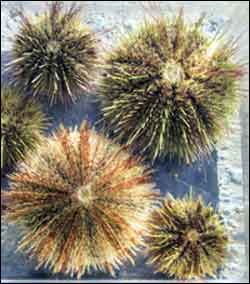Sugar-coated sea urchin eggs could have sweet implications for human fertility

Green sea urchins from the waters off the San Juan Islands in Washington state could help scientists to solve some human reproductive problems. (Photo credit: Christiane Biermann)
For many years scientists have believed they understood how closely related species that occupy the same regions of the ocean were kept from interbreeding. It turns out they were only seeing part of the picture.
New research from the University of Washington’s Friday Harbor Laboratories shows that common assumptions about sea urchin reproduction don’t hold true for all species of the invertebrate creature. The work could lead to better understanding of fertilization among mammals, including the potential to solve some baffling human reproductive problems.
“The importance for people is understanding the process. People come to fertility clinics wondering why their eggs don’t fertilize,” said Christiane Biermann, a research associate at Friday Harbor Labs in Washington state’s San Juan Islands and an adjunct biology faculty member at Portland State University in Oregon.
In some places, different sea urchin species breed at different times of the year, or they occupy different ocean depths, so there is little chance of hybrids turning up. But in other places, such as the waters off the West Coast of North America, the species breed at the same time and occupy the same waters, and still hybrids are rare.
The purple sea urchin has been the most closely studied of the urchins and for years has served as the reproduction model for all sea urchins. Like other species, purple sea urchins are free spawners – females inject large clouds of eggs into the water and males do the same with sperm. Scientists found that the key to species-specific fertilization is a sperm protein called bindin connecting with the correct receptor in the plasma membrane on the surface of the egg. The sperm have to pass through a jelly-like coating, made up of complex carbohydrates, or sugars, to reach the egg surface. They react to the jelly coating by exposing the bindin protein.
It was thought that the egg jelly carbohydrates that activate the bindin were similar in all sea urchin species. In reality, the jelly coating contains a general type of carbohydrate in the purple sea urchin but in other species the jelly becomes a secondary barrier to prevent cross-species breeding. For instance, eggs of the green sea urchin, the purple urchin’s closest relative, have a different kind of carbohydrate, one that doesn’t activate the purple urchin’s sperm. The same holds true for purple urchin eggs and green urchin sperm. That means that just a small chemical change in a sugar molecule can limit fertilization.
The discovery, Biermann said, tells evolutionary biologists that sibling species have found different means to regulate their reproduction. “It helps to understand the process if you think of fertilization as sperm entering through several doors,” she said. “In the past, we have focused on changes in the lock to the egg’s protein door, and how sperm proteins are able to unlock that door. Now we know that eggs can change the lock in the carbohydrate door too.”
Biermann is first author of a paper describing the findings in the September-October edition of the journal Evolution & Development. Co-authors are Jessica Marks of the University of Bergen in Norway; and Ana-Cristina Vilela-Silva, Michelle Castro and Paulo Mourão of the Universidade Federal do Rio de Janeiro in Brazil.
While mammal eggs – mouse and human, for instance – don’t have a thick jelly coating like sea urchin eggs, they do have complex carbohydrate molecules on the surface. It is likely, Biermann said, that those sugars attach to proteins in sperm cells to trigger reproduction. “They are different but they probably do exactly the same thing as sea urchin eggs,” she said.
She noted that proteins are much better understood than sugars, so the role of the proteins in sperm can be studied relatively easily. Figuring out exactly how the complex sugars work will take more research, but developing such understanding, she said, could lead to solutions for human reproductive problems, including new approaches to contraception.
The research also opens the possibility of studying other functions of carbohydrate-signaling molecules. The sugar chains in sea urchins are similar to some found in algae that have a variety of possible medical uses, as anticoagulants and antiviral agents, for example.
The research was supported by Friday Harbor Labs, the State University of New York at Stony Brook, the National Science Foundation, and the Norwegian and Brazilian research councils.
Media Contact
More Information:
http://www.washington.eduAll latest news from the category: Life Sciences and Chemistry
Articles and reports from the Life Sciences and chemistry area deal with applied and basic research into modern biology, chemistry and human medicine.
Valuable information can be found on a range of life sciences fields including bacteriology, biochemistry, bionics, bioinformatics, biophysics, biotechnology, genetics, geobotany, human biology, marine biology, microbiology, molecular biology, cellular biology, zoology, bioinorganic chemistry, microchemistry and environmental chemistry.
Newest articles

Parallel Paths: Understanding Malaria Resistance in Chimpanzees and Humans
The closest relatives of humans adapt genetically to habitats and infections Survival of the Fittest: Genetic Adaptations Uncovered in Chimpanzees Görlitz, 10.01.2025. Chimpanzees have genetic adaptations that help them survive…

You are What You Eat—Stanford Study Links Fiber to Anti-Cancer Gene Modulation
The Fiber Gap: A Growing Concern in American Diets Fiber is well known to be an important part of a healthy diet, yet less than 10% of Americans eat the minimum recommended…

Trust Your Gut—RNA-Protein Discovery for Better Immunity
HIRI researchers uncover control mechanisms of polysaccharide utilization in Bacteroides thetaiotaomicron. Researchers at the Helmholtz Institute for RNA-based Infection Research (HIRI) and the Julius-Maximilians-Universität (JMU) in Würzburg have identified a…



